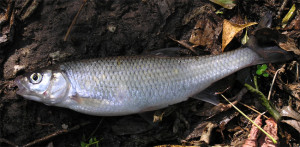 It is present all over Europe east of the Pyrenees and north of the Alps, in Crimea, in Caucasus and the downstream Volga, across Siberia, except for the Pacific rivers. The dace mainly inhabits rivers and running lakes. Present along with dace in rivers usually are carps like chub and ide. Compared to chub, the dace has a differently shaped and colored anal fin. The anal fin in dace is gray or yellowish and slightly notched, whereas chubs have it rounded and of magenta color. Compared to ide, dace are slenderer and have larger scales and different fin colors (the pelvic and anal fins in the ide are maroon). The dace will grow up to 30 cm long and 400 gr of weight. It has a subterminal mouth and feeds at the bottom on bloodworms and other insect larvae, as well as diatoms. During mass emergence of midges, mayflies, or in the events insects are blown off into water from the shore shrubs by wind the dace preys on them coming up to surface waters. The fishermen call it playing fish. This is characteristic of many other ground fish of freshwater. The dace matures after 3 years of life, being 11 -14 cm long. Spawning, depending on the geographical location of the water bodies, happens in March-May, mainly in small tributaries where the water cleanses earlier and becomes more transparent than in the main riverbed. The roe is largish – about 2 mm across, and the fertility is not high – around 17 thousand eggs. The dace lays eggs in one approach to rocky or gravelly loam soils; they also often lay eggs into flooded grass.
It is present all over Europe east of the Pyrenees and north of the Alps, in Crimea, in Caucasus and the downstream Volga, across Siberia, except for the Pacific rivers. The dace mainly inhabits rivers and running lakes. Present along with dace in rivers usually are carps like chub and ide. Compared to chub, the dace has a differently shaped and colored anal fin. The anal fin in dace is gray or yellowish and slightly notched, whereas chubs have it rounded and of magenta color. Compared to ide, dace are slenderer and have larger scales and different fin colors (the pelvic and anal fins in the ide are maroon). The dace will grow up to 30 cm long and 400 gr of weight. It has a subterminal mouth and feeds at the bottom on bloodworms and other insect larvae, as well as diatoms. During mass emergence of midges, mayflies, or in the events insects are blown off into water from the shore shrubs by wind the dace preys on them coming up to surface waters. The fishermen call it playing fish. This is characteristic of many other ground fish of freshwater. The dace matures after 3 years of life, being 11 -14 cm long. Spawning, depending on the geographical location of the water bodies, happens in March-May, mainly in small tributaries where the water cleanses earlier and becomes more transparent than in the main riverbed. The roe is largish – about 2 mm across, and the fertility is not high – around 17 thousand eggs. The dace lays eggs in one approach to rocky or gravelly loam soils; they also often lay eggs into flooded grass.
Dace are school fish migrating very little. Commonly, in the morning dace come out to the nearest rift, and in the evenings go down deep pools or deeper shoreline holes. Sometimes they gather at spawning grounds of other fish to feast on their roe. Dace are of no commercial value.
/ * The photos at lake.peipsi.org are cross-posted from commons.wikimedia.org and are used for familiarization purposes only. No commercial use of the photos is allowed. For more information about to use the photos see the originals on commons.wikimedia.org. /


